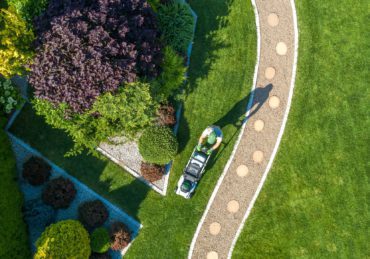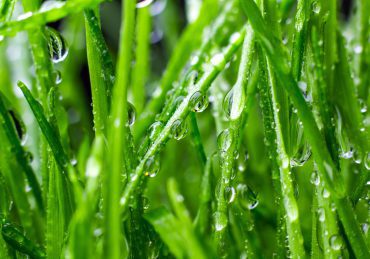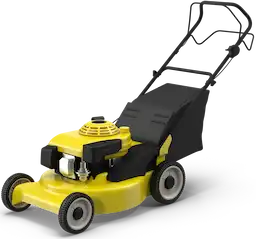There’s nothing more frustrating than stepping outside to admire your lawn, only to find unsightly yellow patches spreading across what should be a lush, green oasis. For homeowners who take pride in their yards, discolored grass can feel like a personal defeat. But don’t worry – your lawn isn’t beyond saving! Grass turns yellow for several reasons, including nutrient deficiencies, improper watering, lawn diseases, mowing mistakes, and even pet damage. Identifying the root cause is the key to restoring your lawn’s health and vibrancy. Is your grass thirsty, overfed, or suffering from a fungal infection? Could your mowing habits be to blame? Diagnosing the issue is the first step to effective treatment. Check out our complete guide to lawn maintenance for year-round grass health. In this article, we’ll break down the most common reasons grass turns yellow and provide practical solutions to help you revive your lawn. With the right care, you can bring back your lawns vibrancy in no time!
Common Reasons Your Grass Is Turning Yellow
Yellowing grass can be caused by a variety of factors, making it essential to pinpoint the exact issue before taking action. Some causes are environmental, such as extreme heat, drought, or poor soil conditions, while others result from improper lawn care practices like overwatering, mowing too short, or using the wrong type of fertilizer. Even pests and lawn diseases can lead to unsightly discoloration. Because multiple factors can contribute to the problem, a careful assessment of your lawn’s condition is necessary to determine the best solution. In the following sections, we’ll break down the most common reasons grass turns yellow, from nutrient deficiencies and watering mistakes to mowing errors and pet-related damage. By understanding these potential culprits, you’ll be better equipped to diagnose the issue and implement the right treatment. Keep reading to learn how to identify the cause of your lawn’s yellowing and restore its healthy, green color.
Easily hire the best lawn & landscape pros working in your neighborhood.
Nutrient Deficiencies and Soil Imbalance
Nitrogen, iron, and other essential nutrients play a crucial role in maintaining a lush, green lawn. Among them, nitrogen is the most important, as it promotes healthy leaf growth and gives grass its rich green color. When a lawn lack nitrogen, grass blades turn pale yellow or light green, grow more slowly and may become thing or patchy. This is one of the most common reasons for yellowing grass, especially in lawns that haven’t been fertilized recently or where nutrients have been leaches away by heavy rain.
To determine whether your lawn is suffering from a nitrogen deficiency or lacking other vital nutrients, a soil test is essential. Home test kits and USDA Soil Testing Resources can help reveal exactly what your soil needs, allowing you to apply the right nutrients. Learn how to choose the best lawn fertilizer for a healthy, green lawn.
For a quick boost, use a nitrogen-rich fertilizer, such as a slow-release granular fertilizer with a balanced N-P-K ratio (like 20-5-10). Organic options include compost, manure, and blood meal, which improve soil health while providing essential nutrients. Grass clippings left on the lawn after mowing also naturally return nitrogen to the soil. By properly nourishing your lawn, you can restore its color and promote long-term health.
Watering Problems: Overwatering or Underwatering
Correct watering plays a crucial role in maintaining a healthy, green lawn, but both too much and too little can lead to yellowing grass. Overwatering suffocates the roots by preventing proper oxygen flow, leading to weak, shallow roots and making the lawn more susceptible to disease. Signs of overwatering include consistently soggy soil, fungal growth (such as mushrooms or mold), and grass that feels soft or spongy underfoot.
On the other hand, underwatering deprives the grass of the moisture it needs to stay green and healthy. When grass doesn’t receive enough water, it turns dry, brittle, and may grow slower. A common sign of dehydration is footprints that linger after walking on the lawn, indicating a lack of resilience in the grass blades.
To maintain proper moisture levels, adjust your watering schedule based on the season and grass type. In general, most lawns need about 1 to 1.5 inches of water per week, delivered in deep, infrequent sessions. Cool-season grasses (like fescue and bluegrass) require more frequent watering in summer, while warm-season grasses (like Bermuda and Zoysia) thrive with less water. Additionally, it’s important to follow responsible watering practices when determining your watering schedule. Water early in the morning to minimize evaporation, and adjust for rainfall to prevent overwatering. Proper hydration keeps your lawn lush and vibrant year-round. Discover the best watering techniques for your lawn.
Mowing Mistakes and Lawn Stress
Mowing your lawn too short, a practice known as “scalping,” can weaken the grass and cause it to turn yellow. When grass is cut too low, it struggles to photosynthesize effectively, limiting its ability to produce energy for healthy growth. Additionally, shorter grass exposes the roots to excessive heat and drought stress, making the lawn more vulnerable to drying out and turning yellow.
Another common mowing mistake is using dull mower blades. When blades are dull, they tear the grass instead of making clean cuts, leaving ragged edges that turn yellow or brown as they dry out. Regularly sharpening your mower blades, at least once per season, ensures a clean cut that promotes healthy regrowth.
To maintain a healthy lawn, follow recommended mowing heights for different grass types. Cool-season grasses like Kentucky bluegrass and fescue should be kept at 2.5 to 4 inches, while warm-season grasses like Bermuda and Zoysia, thrive at 1 to 2 inches. Adjust mowing habits based on the season, allowing grass to grow slightly taller during how summer months to improve drought resistance. Avoid these common mowing mistakes to keep your lawn healthy.
Lawn Diseases That Cause Yellow Grass
Lawn diseases are a common culprit behind yellowing grass, often appearing as patchy discoloration or powdery coatings on grass blades. Some of the most frequent diseases include lawn rust, dollar spot, and other fungal infections, all of which thrive under certain environmental conditions.
Lawn rust is identified by an orange-yellow dust that coats grass blades, making them appear rusty when touched. It typically develops in lawns that are stressed due to poor nutrition, drought, or excessive shade. Dollar spot appears as small, round yellow or tan patches, often merging into larger areas if left untreated. It thrives in humid conditions and frequently affected underfed lawns. Other fungal infections can cause yellowing when grass is exposed to excessive moisture, poor drainage, or compacted soil, which restricts airflow and promotes disease development.
Preventing lawn diseases starts with proper lawn care. Avoid overwatering, improve soil drainage, and aerate compacted soil to enhance air circulation. Mow at the correct height and fertilize appropriately to keep the lawn strong and disease-resistant. If fungal infections take hold, applying a fungicide containing azoxystrobin or propiconazole can help control the spread. Organic solutions, such as applying compost tea or neem oil, can also support grass health.
By maintaining good lawn care practices, such as watering deeply but infrequently, mowing with sharp blades, and improving soil quality, you can learn how to spot and treat common lawn diseases.
Easily hire the best lawn & landscape pros working in your neighborhood.
Pests and Insects Damaging Your Lawn
Lawn pests like grubs, chinch bugs, and other insects can cause yellow patches in your lawn by feeding on grass roots and blades, weakening the lawn over time. Lawn grubs, the larvae of beetles such as Japanese beetles and June bugs, burrow beneath the soil and eat grass roots, causing dead spots that peel up easily like loose carpet. Chinch bugs, on the other hand, such moisture from grass blades, leaving behind dry, yellow, or brown patches that spread quickly in hot, dry weather. Other pests, such as sod webworms and armyworms, also contribute to lawn damage by chewing through grass blades.
Signs of an infestation include irregular yellow or brown patches, weak or thinning grass, and visible larvae or insects when you life the turf. To check for grubs, peel back a small section of lawn – finding more than 10 grubs per square foot indicates a problem.
For natural pest control, encourage predators like birds and beneficial nematodes, which feed on lawn grubs. Milky spore powder is also an organic option for grub control. If the infestation is severe, apply a lawn insecticide containing imidacloprid or bifenthrin to eliminate pests. Regular lawn care, including proper watering and aeration, and research is important to protect your lawn from destructive pests.
Pet Damage: Urine Spots and Traffic Stress
Dog urine contains high nitrogen levels, which can create yellow spots on your lawn, similar to fertilizer burn. While nitrogen is essential for healthy grass growth, concentrated amounts in urine overwhelm the soil, causing discoloration and dead patches. Female dogs often cause more noticeable damage since they tend to urinate in one spot rather than marking multiple areas.
To minimize pet damage, train your dog to use a designated area with mulch or gravel instead of grass. Watering the affected area immediately after your dog urinates help dilute the nitrogen and prevent burning. Lawn repair treatments, such as overseeding and applying soil conditioners, can help restore damaged spots.
Additionally, high foot traffic from pets and people can compact soil and weaken grass, creating a yellow lawn or simply killing your grass. Aerate the compacted areas and use stepping stones or pathways to direct traffic away from vulnerable areas of your lawn. For other tips for maintaining a healthy lawn with pets, visit us at LawnGuru.
How to Fix Yellow Grass and Restore a Healthy Lawn
Keeping your lawn green and healthy requires a combination of proper care and quick action when issues arise. Here’s a quick checklist to fix yellow grass and prevent future problems:
- Check soil nutrients – Perform a soil test and apply a nitrogen-rich or balanced fertilizer if needed. Use organic options like compost or grass clippings for long-term soil health.
- Water Properly – Avoid overwatering or underwatering. Most lawns need 1 to 1.5 inches of water per week, applied deeply and infrequently. Water early in the morning to reduce evaporation and fungal risk.
- Mow correctly – Keep mower blades sharp for clean cuts and follow recommended mowing heights (2.5-4 inches for cool-season grass, 1-2 inches for warm-season grass).
- Prevent lawn diseases – Improve drainage, aerate compacted soil, and apply fungicides if necessary.
- Control pests – Check for grubs and chinch bugs, and use natural or chemical treatments as needed.
- Manage pet damage – Train dogs to use specific areas, water urine spots immediately, and overseed damaged patches.
By maintaining a consistent lawn care routine, you can prevent yellowing and enjoy a lush, green lawn year-round.
Fertilization Tips for a Greener Lawn
Choosing the right fertilizer depends on your soil test results, which reveal nutrient deficiencies and pH imbalances. If your lawn lacks nitrogen, use a slow-release fertilizer with a high first number in the N-P-K ratio, such as 20-5-10, to promote steady, long-term growth. For iron deficiencies, which cause pale yellow grass, apply an iron supplement or fertilizer with added iron, like Milorganite. If your soil is low in phosphorus or potassium, use a balanced fertilizer such as 10-10-10 to support root strength and overall health. The ultimate guide for fertilizing your lawn can be found on LawnGuru, giving you first steps to the best solution for your lawn.
Slow-release fertilizers, whether synthetic or organic (like compost, manure, or blood meal), feed your lawn gradually, to reduce the risk of nutrient burn and promote deep root development. Apply fertilizer in early spring and fall for cool-season grasses, and in late spring and summer for warm-season grasses. Regular feeding based on soil needs ensures a lush, green lawn all season long.
Easily hire the best lawn & landscape pros working in your neighborhood.
Proper Lawn Watering Techniques
Proper watering techniques are essential for maintaining a healthy, green lawn. Deep, infrequent watering is far more effective than frequent shallow watering. Shallow watering encourages weak, surface-level roots, making grass more vulnerable to drought and stress. Instead, aim to water deeply, providing about 1 to 1.5 inches per week, which promotes strong, deep root growth.
The best time to water your lawn is early morning, between 6 AM and 10 AM, when temperatures are cool, and the sun helps dry excess moisture, reducing the risk of fungal diseases. Evening watering can also work, but it’s less ideal because prolonged moisture overnight can encourage mold and fungus.
To check if your lawn is watered enough, push a screwdriver into the soil – it should penetrate at least 6 inches easily. Adjust your watering schedule based on rainfall, and use sprinklers or soaker hoses to ensure even coverage.
Aeration and Soil Care for Better Grass Health
Soil compaction is a common problem that prevents grass from absorbing water, air, and nutrients, leading to weak root growth and yellowing grass. When soil becomes too dense – often due to heavy foot traffic, mowing, or clay-heavy soil – grass roots struggle to spread, making the lawn more susceptible to drought, disease, and nutrient deficiencies.
Aeration is the best solution for compacted soil. This process involves removing small plugs of soil to create pathways for air, water, and nutrients to reach the roots. Aerating in the spring or fall helps relieve compaction and encourages deeper root growth.
Pairing aeration with overseeding further improves lawn health. Overseeding introduces new, resilient grass varieties that fill in thin or yellowed ares, boosting overall density. After aeration, spreading grass seed and a light layer of compost helps establish a stronger, greener lawn. Regular aeration and overseeding ensure long-term lawn vitality and prevent yellowing.
Preventing Lawn Diseases and Pest Infestations
Preventing lawn diseases starts with proactive care to create an environment where grass thrives and fungi or pests struggle to take hold. Avoid overwatering, as excess moisture encourages fungal growth – water deeply but infrequently, preferably in the early morning. Keep your lawn well-fed with a balanced fertilizer, as nutrient-deficient grass is more susceptible to disease. Regular aeration improves drainage and airflow, reducing the risk of fungal infections.
To prevent pest-related yellowing, monitor your lawn for early signs of infestation, such as thinning grass or visible larvae. Natural pest control methods include introducing beneficial nematodes to combat grubs and encouraging birds, which eat lawn pests. If an infestation becomes severe, apply a chemical insecticide containing imidacloprid or bifenthrin, following label instructions carefully.
Maintaining proper mowing, watering, and fertilization habits strengthens your lawn’s natural defenses, reducing the likelihood of diseases and pest damage before they become a serious issue.
Keep Your Lawn Green and Healthy Year-Round
Yellowing grass can be caused by a variety of factors including nutrient deficiencies, watering too much or too little, mowing mistakes, lawn diseases, pests, and pet damage. Understanding theroot cause is key to reviving your grass. Regular lawn care – including proper fertilization, deep watering, correct mowing habits, aeration, and pest control – prevents common causes before they start. Testing your soil ensures your lawn gets the right nutrients, while adjusting watering habits helps maintain healthy root growth. If you notice signs of disease or isnect damage, early intervention with natural or chemical treatments can save your turf from further decline. For long-term success, commit to consistent lawn care practices and make small adjustments as needed throughout the seasons. Ready to revive your lawn? Start with a soil text, fine-tune your watering routine, or consult a professional lawn care service for expert guidance. Follow our seasonal lawn care checklist for year-round success.





